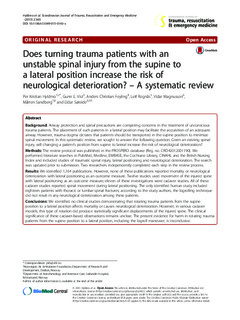| dc.contributor.author | Hyldmo, Per Kristian | |
| dc.contributor.author | Vist, Gunn E. | |
| dc.contributor.author | Feyling, Ander Christian | |
| dc.contributor.author | Rognås, Leif | |
| dc.contributor.author | Magnusson, Vidar | |
| dc.contributor.author | Sandberg, Mårten | |
| dc.contributor.author | Søreide, Eldar | |
| dc.date.accessioned | 2016-04-06T08:41:15Z | |
| dc.date.available | 2016-04-06T08:41:15Z | |
| dc.date.issued | 2015-09 | |
| dc.identifier.citation | Hyldmo, P.K et al. (2015) Does turning trauma patients with an unstable spinal injury from the supine to a lateral position increase the risk of neurological deterioration? – A systematic review. Scandinavian Journal of Trauma, Resuscitation and Emergency Medicine , 23:65 | nb_NO |
| dc.identifier.uri | http://hdl.handle.net/11250/2384184 | |
| dc.description | This article was originally published in the Scandinavian Journal of Trauma, Resuscitation and Emergency Medicine. This article is distributed under the terms of the Creative Commons Attribution 4.0
International License (http://creativecommons.org/licenses/by/4.0/), which permits unrestricted use, distribution, and
reproduction in any medium, provided you give appropriate credit to the original author(s) and the source, provide a link to
the Creative Commons license, and indicate if changes were made. | nb_NO |
| dc.description.abstract | Background
Airway protection and spinal precautions are competing concerns in the treatment of unconscious trauma patients. The placement of such patients in a lateral position may facilitate the acquisition of an adequate airway. However, trauma dogma dictates that patients should be transported in the supine position to minimize spinal movement. In this systematic review, we sought to answer the following question: Given an existing spinal injury, will changing a patient’s position from supine to lateral increase the risk of neurological deterioration?
Methods
The review protocol was published in the PROSPERO database (Reg. no. CRD42012001190). We performed literature searches in PubMed, Medline, EMBASE, the Cochrane Library, CINAHL and the British Nursing Index and included studies of traumatic spinal injury, lateral positioning and neurological deterioration. The search was updated prior to submission. Two researchers independently completed each step in the review process.
Results
We identified 1,164 publications. However, none of these publications reported mortality or neurological deterioration with lateral positioning as an outcome measure. Twelve studies used movement of the injured spine with lateral positioning as an outcome measure; eleven of these investigations were cadaver studies. All of these cadaver studies reported spinal movement during lateral positioning. The only identified human study included eighteen patients with thoracic or lumbar spinal fractures; according to the study authors, the logrolling technique did not result in any neurological deterioration among these patients.
Conclusions
We identified no clinical studies demonstrating that rotating trauma patients from the supine position to a lateral position affects mortality or causes neurological deterioration. However, in various cadaver models, this type of rotation did produce statistically significant displacements of the injured spine. The clinical significance of these cadaver-based observations remains unclear. The present evidence for harm in rotating trauma patients from the supine position to a lateral position, including the logroll maneuver, is inconclusive. | nb_NO |
| dc.language.iso | eng | nb_NO |
| dc.publisher | BioMed Central | nb_NO |
| dc.rights | Navngivelse 3.0 Norge | * |
| dc.rights.uri | http://creativecommons.org/licenses/by/3.0/no/ | * |
| dc.subject | trauma | nb_NO |
| dc.subject | spinal injuries | nb_NO |
| dc.subject | ryggmargsskade | nb_NO |
| dc.subject | nevrologi | nb_NO |
| dc.title | Does turning trauma patients with an unstable spinal injury from the supine to a lateral position increase the risk of neurological deterioration? – A systematic review | nb_NO |
| dc.type | Journal article | nb_NO |
| dc.type | Peer reviewed | nb_NO |
| dc.rights.holder | © 2015 Hyldmo et al. | nb_NO |
| dc.subject.nsi | VDP::Medical disciplines: 700 | nb_NO |
| dc.source.journal | Scandinavian Journal of Trauma, Resuscitation and Emergency Medicine | nb_NO |
| dc.identifier.doi | 10.1186/s13049-015-0143-x | |

